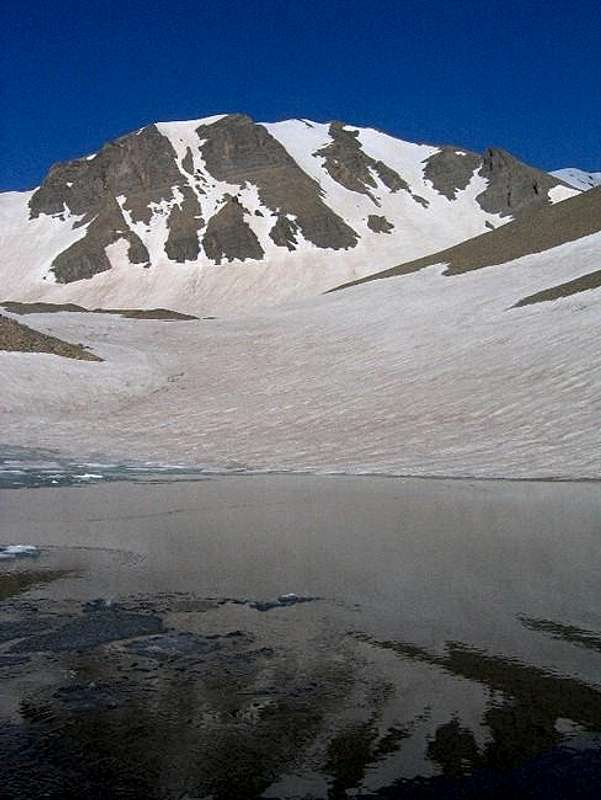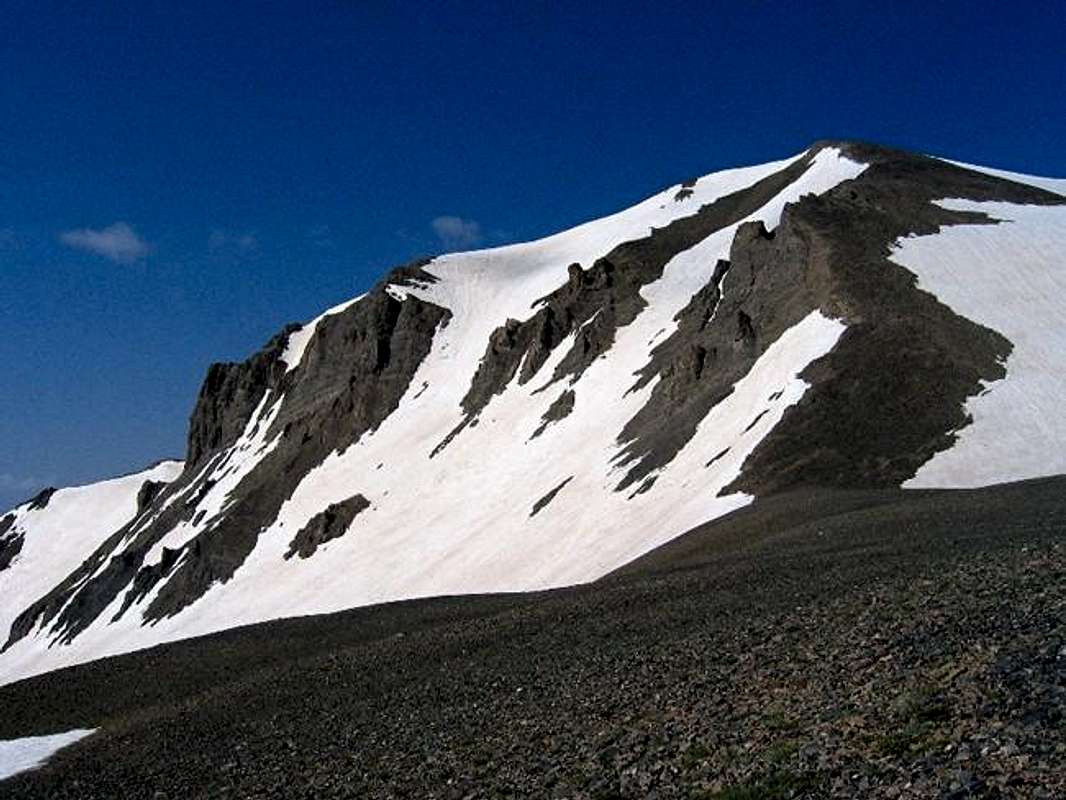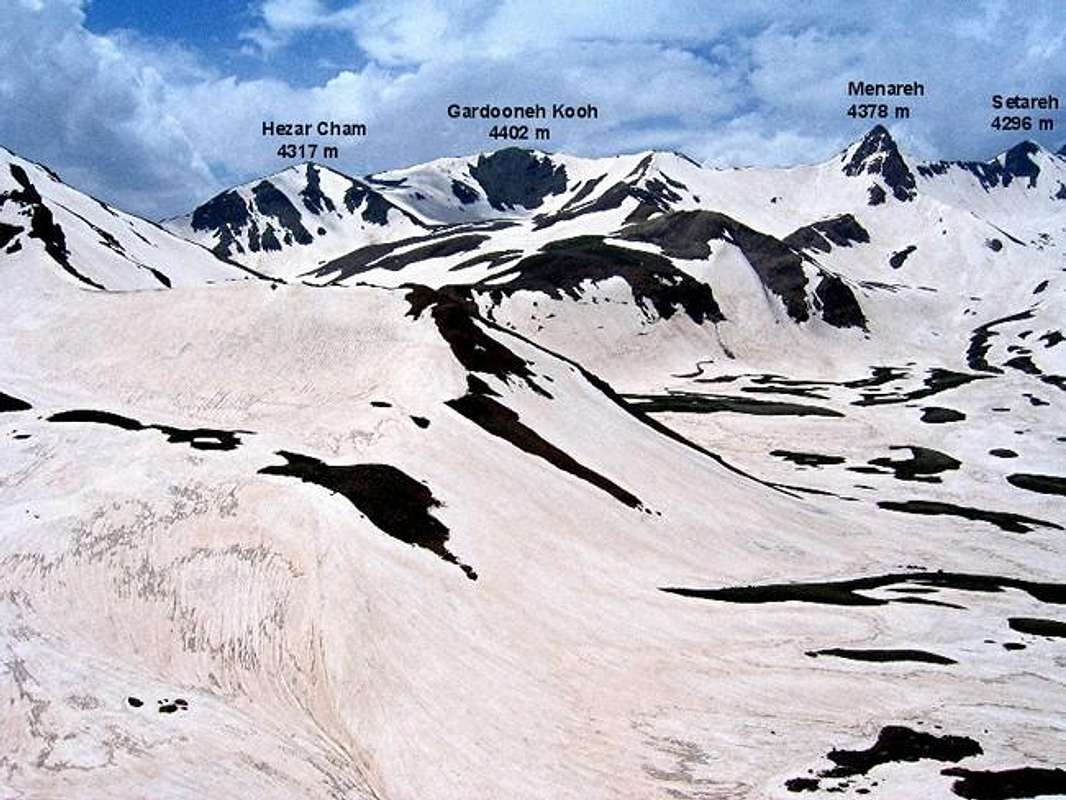|
|
Mountain/Rock |
|---|---|
|
|
36.33980°N / 50.96400°E |
|
|
14163 ft / 4317 m |
|
|
Overview
NOTES:Click for Introduction to Takhte Soleyman Massif.
Click for a map of Central Alborz.
Click for a map of Takhte Soleyman Massif.
Click for an aerial photo of Takhte Soleyman Massif.
My GPS/altimeter showed the elevation of this peak to be 14190 ft (4325 m). The 4317 m figure is per the 1:50 000 map mentioned below.


Hezar Cham is one of the southern peaks of the Takhte Soleyman Massif. To the northwest, Hezar Cham is connected to the 4402 m (14442 ft) Gardooneh Kooh Peak. A one room shelter can be found on the ridgeline that connects these two peaks. To the southeast, a 4090 m (13419 ft) saddle known as Hezar Cham Pass separates Hezar Cham Peak from Lashgarak the Great Peak (4256 m, 13963 ft). On the eastern slopes below the pass, there is a large permanent snow field/small glacier. In summer, a pond that reflects Hezar Cham is usually formed at the base of this glacier.
Hezar Cham, along with Gardooneh Kooh, Menareh and Lashgarak the Great form a series of peaks that rise to the west and southwest of Hesar Chal, a roughly circular plateau with an approximate diameter of 1.5 km (one mile) that sits at an elevation of 3600-4000 m (11800-13100 ft). Hesar Chal is a day’s hike from the village of Roodbarak (1400 m, 4700 ft), the traditional starting place for climbing the peaks of the Takhte Soleyman Massif. Hesar Chal is an ideal spot for overnight camping and can provide access to many other local peaks. From Hesar Chal, you can follow any path up the fairly steep slopes of Hezar Cham to reach its summit. Hezar Cham is usually climbed along with its nearby peaks as part of a traverse of the southern peaks of the Takhte Soleyman Massif.
Hezar Cham Pass was the highest point on a trail that used to connect Sardab Rood River Valley on the Caspian side to the Taleghan Valley (Shah Rood River Valley) (see map). Before the establishment of the Karaj-Chalus Road in the 1930s, this trail used to serve as a connecting route between the Caspian Coast and the southern slopes of the Alborz Mountains. “Hezar Cham” means “A thousand Curves” and probably referred to the many curves/switchbacks on that trail.
Getting There
See Map.From downtown Tehran drive 40 km west to the town of Karaj and take the Karaj-Chalus Road north (This road crosses the Alborz Mountains taking you through the Kandovan Tunnel to the Caspian Coast). 30 km south of Chalus, you will reach the town of Marzan Abad. Turn left and follow a side road into the Sardab Rood River drainage and to the town of Roodbarak. Distance from Tehran to Roodbarak is roughly 200 km (125 miles)
Red Tape
I am not aware of any permit or fee requirement. Hunting will require a license.
When To Climb
June to October is the ideal season. Climbing in winter will obviously be much harder due to extreme cold and heavy snow cover.Camping
Accommodations are available at the Iran Mountaineering Federation Hotel in Roodbarak (call Mountaineering Federation at 98 21 8839928) or camp anywhere.Mountain Conditions
In summer, the weather is generally clear. Unexpected thunderstorms do occur frequently. Precipitation at higher elevations will almost always be in the form of snow/hail.Miscellaneous Info
TOURS/GUIDES:If you are not familiar with these mountains, you will greatly benefit from the presence of a guide. I worked with Araz Adventure Tours and was very satisfied with their services. They were flexible, courteous and knowledgeable and were able to custom design an 8 day trekking tour allowing me to climb the lesser known peaks of the area. My guide: Mr. Rasool Naghavi was a kind man who was a native of Roodbarak and knew the mountains like the back of his hand. Having climbed Everest and several other Himalayan giants made him, in my opinion, one of the most qualified guides for these mountains.
MAPS:
1) The most accurate topographical maps of the area are those with a scale of 1:50 000 (contour lines of 20 m) provided by the Iranian Armed Forces. You will need sheet #6162 I "Shahrestanak" for Gardooneh Kooh and Alam Kooh (To fully cover the entire Takhte Soleyman Massif, you will also need sheet #6262 IV "Rudbarak"). These maps are available in Tehran at the Geographical Office of the Armed Forces on Moalem St. (98 21 8408088) for the equivalent of $3 per sheet (in 2004). Outside of Iran, the same maps can be purchased at www.cartographic.com for the exorbitant price of $150 per sheet (in 2003). These maps are in Farsi. While they give the exact elevation of most of the peaks, they do not give the names of the individual peaks.
2) Soviet Military Maps sheet # J-39-126-G available at www.omnimap.com. I do not recommend this map. It seems as if the creators of this map lacked detailed info and eliminated many of the lower peaks.
3) Different schematic maps available in Iran. My favorite is the "Guide Map of Takht-e-Soleiman & Alam Kuh Region" by Iran Kuhro Co. available at Varzesh Kooh store, Ferdowsi Sq., Tehran (98 21 8826642).









